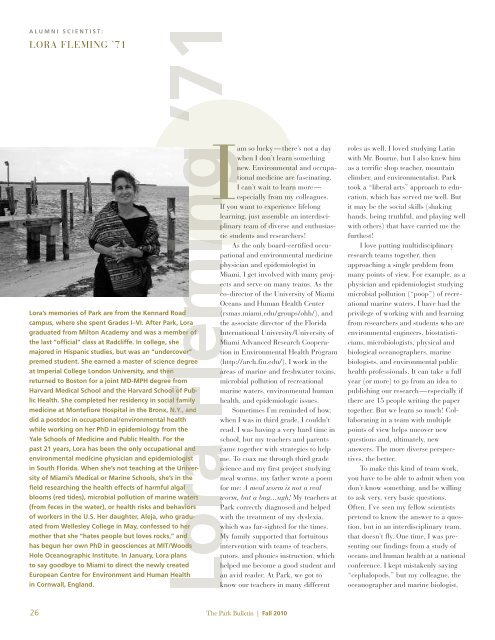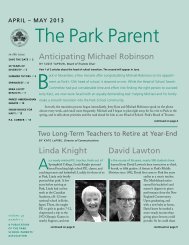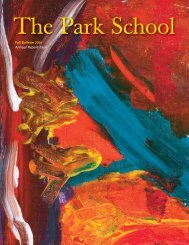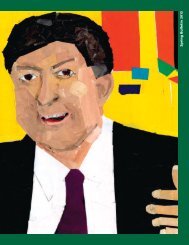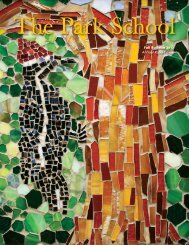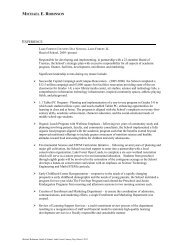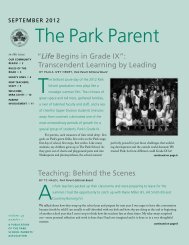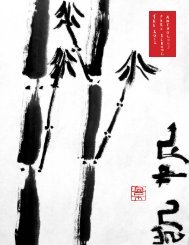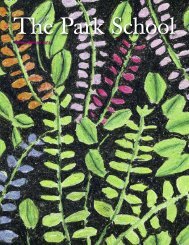⢠ParkBulletinCover - The Park School
⢠ParkBulletinCover - The Park School
⢠ParkBulletinCover - The Park School
- No tags were found...
Create successful ePaper yourself
Turn your PDF publications into a flip-book with our unique Google optimized e-Paper software.
A L U M N I S C I E N T I S T :LORA FLEMING ’71Lora’s memories of <strong>Park</strong> are from the Kennard Roadcampus, where she spent Grades I–VI. After <strong>Park</strong>, Loragraduated from Milton Academy and was a member ofthe last “official” class at Radcliffe. In college, shemajored in Hispanic studies, but was an “undercover”premed student. She earned a master of science degreeat Imperial College London University, and thenreturned to Boston for a joint MD-MPH degree fromHarvard Medical <strong>School</strong> and the Harvard <strong>School</strong> of PublicHealth. She completed her residency in social familymedicine at Montefiore Hospital in the Bronx, N.Y., anddid a postdoc in occupational/environmental healthwhile working on her PhD in epidemiology from theYale <strong>School</strong>s of Medicine and Public Health. For thepast 21 years, Lora has been the only occupational andenvironmental medicine physician and epidemiologistin South Florida. When she’s not teaching at the Universityof Miami’s Medical or Marine <strong>School</strong>s, she’s in thefield researching the health effects of harmful algalblooms (red tides), microbial pollution of marine waters(from feces in the water), or health risks and behaviorsof workers in the U.S. Her daughter, Aleja, who graduatedfrom Wellesley College in May, confessed to hermother that she “hates people but loves rocks,” andhas begun her own PhD in geosciences at MIT/WoodsHole Oceanographic Institute. In January, Lora plansto say goodbye to Miami to direct the newly createdEuropean Centre for Environment and Human Healthin Cornwall, England.Iam so lucky —there’s not a daywhen I don’t learn somethingnew. Environmental and occupationalmedicine are fascinating.I can’t wait to learn more —especially from my colleagues.If you want to experience lifelonglearning, just assemble an interdisciplinaryteam of diverse and enthusiasticstudents and researchers!As the only board-certified occupationaland environmental medicinephysician and epidemiologist inMiami, I get involved with many projectsand serve on many teams. As theco-director of the University of MiamiOceans and Human Health Center(rsmas.miami.edu/groups/ohh/), andthe associate director of the FloridaInternational University/University ofMiami Advanced Research Cooperationin Environmental Health Program(http://arch.fiu.edu/), I work in theareas of marine and freshwater toxins,microbial pollution of recreationalmarine waters, environmental humanhealth, and epidemiologic issues.Sometimes I’m reminded of how,when I was in third grade, I couldn’tread. I was having a very hard time inschool, but my teachers and parentscame together with strategies to helpme. To coax me through third gradescience and my first project studyingmeal worms, my father wrote a poemfor me: A meal worm is not a realworm, but a bug…ugh! My teachers at<strong>Park</strong> correctly diagnosed and helpedwith the treatment of my dyslexia,which was far-sighted for the times.My family supported that fortuitousintervention with teams of teachers,tutors, and phonics instruction, whichhelped me become a good student andan avid reader. At <strong>Park</strong>, we got toknow our teachers in many differentroles as well. I loved studying Latinwith Mr. Bourne, but I also knew himas a terrific shop teacher, mountainclimber, and environmentalist. <strong>Park</strong>took a “liberal arts” approach to education,which has served me well. Butit may be the social skills (shakinghands, being truthful, and playing wellwith others) that have carried me thefurthest!I love putting multidisciplinaryresearch teams together, thenapproaching a single problem frommany points of view. For example, as aphysician and epidemiologist studyingmicrobial pollution (“poop”) of recreationalmarine waters, I have had theprivilege of working with and learningfrom researchers and students who areenvironmental engineers, biostatisticians,microbiologists, physical andbiological oceanographers, marinebiologists, and environmental publichealth professionals. It can take a fullyear (or more) to go from an idea topublishing our research—especially ifthere are 15 people writing the papertogether. But we learn so much! Collaboratingin a team with multiplepoints of view helps uncover newquestions and, ultimately, newanswers. <strong>The</strong> more diverse perspectives,the better.To make this kind of team work,you have to be able to admit when youdon’t know something, and be willingto ask very, very basic questions.Often, I’ve seen my fellow scientistspretend to know the answer to a question,but in an interdisciplinary team,that doesn’t fly. One time, I was presentingour findings from a study ofoceans and human health at a nationalconference. I kept mistakenly saying“cephalopods,” but my colleague, theoceanographer and marine biologist,26 <strong>The</strong> <strong>Park</strong> Bulletin | Fall 2010


